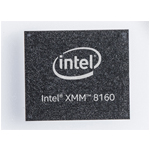 A new Intel 5G modem announced today and scheduled for delivery in the first half of 2019, is based on a single chip and is designed to support speeds up to 6 Gbps. The modem is expected to be used in phones, personal computers and broadband access gateways targeted for availability in the first half of 2020.
A new Intel 5G modem announced today and scheduled for delivery in the first half of 2019, is based on a single chip and is designed to support speeds up to 6 Gbps. The modem is expected to be used in phones, personal computers and broadband access gateways targeted for availability in the first half of 2020.
Intel also noted that the new modem chip will support a wide range of use cases, including standalone and non-standalone modes.
What’s the difference?
Standalone Vs. Non-Standalone 5G
Intel notes in a press release that both standalone and non-standalone modes are described in the 5G NR standard. 5G NR is the latest wireless standard developed by standards body 3GPP.
As technology website Mediatek explains, the non-standalone mode is designed to be supported, in part, by existing 4G infrastructure. It calls for 5G frequencies to be used for data throughput but uses 4G for non-data activities such as communicating with cell towers and servers. The earliest 5G deployments are based on the non-standalone version of 5G, which was developed to hasten those deployments.
Standalone 5G doesn’t require the 4G underpinning and is expected to support more cost-effective deployment and additional capabilities.
As Intel explains, the new 5G modem, which carries Intel part number XMM 8160, also supports capabilities such as:
- Support for 2G, 3G, and 4G legacy radios, as well as 5G NR
- Support for advanced technology needed to support new millimeter wave spectrum as well as sub-6 GHz 5G NR support (including FDD and TDD) bands from 600 MHz to 6 GHz
Millimeter wave spectrum traditionally was considered unusable for commercial wireless service because it has relatively short range. But some carriers now see it as the best means of delivering the highest-speed 5G services. Both AT&T and Verizon are using millimeter wave spectrum in their initial 5G deployments.
The upshot of today’s news, according to Intel, is that XMM 8160 5G modem will give device manufacturers the ability to design smaller and more power-efficient devices.
Intel isn’t the only component manufacturer pursuing 5G opportunities. Qualcomm also is a key player, for example.
